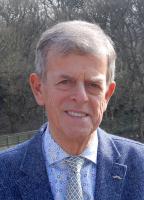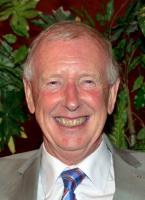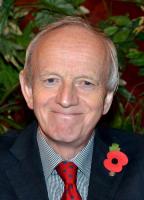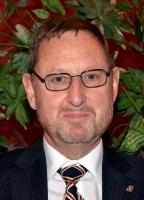Speaker Andy Wilson from Yorkshire Cancer Research
Wed, Jun 25th 2025 at 12:00 pm - 2:00 pm
Andy's talk was entitled Bombs and dealt with the discovery of chemotherapy because of mustard gas bombs. Speaker Finder David Burrows, Visitors Host, Grace & Banners John Watson, Cash Desk John Waterhouse
Andy started off by saying that the general misconception is that chemotherapy was discovered when the Germans bombed Bari Port in Italy in 1943: -
Work in the 1940's on chemotherapy
After the defeat of Rommel in Africa 200,000 allied troops were directed to take Italy. But to fool the Germans a fake operation named “Mincemeat” was set up to get the Germans to move a part of their force to defend Greece rather than Italy. This allowed the allied forces to take Sicily within 6 weeks They then moved to the mainland where their main goal was to take the large port of Bari. Today, Bari, which is the home of the Basilica of St Nicholas, is a laid back & sleepy but in 1943 WWII it was a major port. The Allies viewed it as an important staging area and having taken it moved a lot of ships into the port. However, the port was only lightly defended, and they didn’t do anything to beef up the defences as they thought it was too far away from the Germans. But on the 2nd on December 1943 a single Luftwaffe saw the lack of defences and reported it back to his headquarters. At 7:30pm that night the Germans bombed the port to smithereens and 2 ammunition ships were blown up. The whole attack was hushed up until 1970s.
At the time the U.S. SS John Harvey was in the port carrying 2,000 mustard gas bombs. The use of chemical weapons had been banned by international treaty following the horrors of WWI. Unfortunately, the manufacture and stockpiling of such weapons hadn’t been banned. Roosevelt was worried that the Germans were about to use mustard gas, so he sent a stockpile of the gas bombs to Italy to be used in retaliation if they did attack using the gas. The ship was damaged but not sunk and gas escaped. Mustard gas burns a lot of membranes - eyes, throat, lungs and skin. Survivors of the attack were taken to hospital, but the rescuers wrapped them up in blankets not knowing that they were trapping the gas in. When they got to the hospital again nobody told the medics it was mustard gas burns. Iy wasn’t until Lieutenant Colonel Stewart Alexander saw the patients and realised it was mustard gas that the staff started to treat for the effects. He went to the harbour and worked out where the gas had come from. He then wrote a report specifying that there were 2 peaks of death the first from the effects of the gas, and a second where patients were struggling to breath because of low white cells. In other words, the gas had compromised their immune system.
Alfred Gilman and Louis Goodman had already been studying mustard gas with a view to developing an antidote. They had also noted the immune suppression caused by the gas. wrote theory if chemotherapy. Combining their earlier research with the knowledge gained from the Bari incident they wrote their landmark article in September 1946 detailing how mustard gas therapy could help to alleviate some cancers of the blood and lymph system.
Earlier work on chemotherapy
The truth behind the development of chemotherapy is, however, much more complicated: -
The Germans first used mustard gas in July 1917 at Ypres. Soldiers woke up to strange cloud and 2000 soldiers died. Lots of them were blinded. By the end of WWI there had been 1 million casualties and 90,000 deaths caused by the gas. When treating patients in a field hospital for the effects of gas poisoning Edward Bell Krumbhaar and Helen Dixon Krumbhaar saw and reported it caused white cell deficiency.
This takes us to Isaac Berenblum who was born in 1903 fled Bialystok, Poland. In 1906 because of a pogrom against the Jews his family was forced to flee to Belgium and then 8 years because of the war they fled again to Bristol. Berenblum wanted to study chemistry at university, but his teachers told him that as he was no good at maths and physics, he should study medicine instead. He went to Leeds University to study medicine, but his tutors realised that he was so good at chemistry that they moved him over to physiology and biochemistry.
In 1929 he was one of the first recruits into the new cancer research department in Leeds. Under He began studying skin cancer and ran an experiment using mustard gas to find out if cancer tumours grew more quickly in tissue which had a rich blood supply. To undertake these hyperaemia tests, he took 2 batches of mice and treated them with a sticky tar that was known to cause cancers, but one batch were also given an irritant to cause hyperaemia. He was surprised to find that whilst 100% of the mice given the tar alone got cancer while only 8% of those got cancer because of the chemotherapy effect of the mustard gas.
Picking up on this in 1931 Frank Adaire and Halsey Bagg successfully treated 13 skin cancer patients but they for unknown reasons they didn’t do any further research and moved onto other things.
It was not until 1942 that the work was picked up by Gilman & Goodman who started treating lymphoma with mustard gas. Dr Gustaf Lindskog had a patient - JD a 48-year-old Polish bachelor who was being treated at Newhaven CT for advanced lymphosarcoma, but this was unsuccessful. In August 1942 his situation hopeless and the end was near. He agreed to be guinea pig on the Gilman and Goodman trial. After 1 month of mustard gas the lump on neck his disappeared s but it came back twice. On the third treatment the cancer didn’t go away, and JD died after 96 days.
An up to date situation on cancer
To give an example of the effects of how a cancerous cell developed Andy showed a chess board of 64 squares with one grain of rice on square 1. This then doubled in size to 2 grains on square 2 and 4 on square 3 and so on. By the time you get to square 64 the doubling effect is such that the resulting number is so great as to be not understandable. He said that there would be enough rice on that square to cover the whole of India to a depth of 1 metre. This explains the problem of resistance when 1 cell becomes immune to mustard gas then the number of resistant cells doubles daily.
Today there are over 100 types of chemotherapy, and it can be used both as a treatment and as a complimentary treatment with other things such as radiotherapy.
The latest work by Cancer Research are the Foxtrot trials. In Foxtrot 1 chemotherapy was given before and after surgery and this proved a big success. But the trial was perfect as elderly and frail patients were not included. So, Foxtrot 2 and 3 were to test giving chemotherapy to elderly and frail prior to surgery. Now Foxtrot 4 is being run to try giving younger patients an even bigger early dose.
In adults a lot of cells don't divide such as those in the liver and bones, but an adult body still make 3.8 million cells a second. The blood, stomach, bowels and hair cells all actively reproduce which explains why chemotherapy causes all these to stop dividing. This. therefore, impairs the immune system, the digestive system and causes loss of hair. This is why it is given in phases with a rest in between to allow the body to recover.
Dr David Nathan made a film where he said that in the 1950s he treated 50 children with leukaemia and lost all 50. But today he only loses very few.
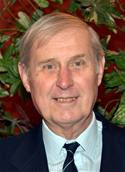 Contact David Burrows about this page:
Contact David Burrows about this page:
'What We Do' Main Pages:
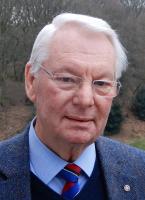
Coming under Community this part of the group exists to undertake environmental projects on behalf of the club.
more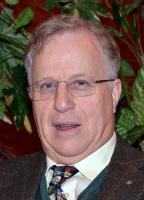
This committee provides the link with Rotary Internationals main charitable trust which primarily deals with projects having a global nature.
more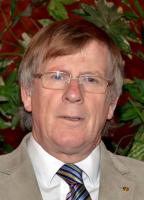
Rotary is not just about doing good deeds but also about enjoying yourself and this committee organises social activities. This page contains an archive of some of our activities.
moreThis committee works with the other committees to help them raise funds for their individual projects to support charities locally, nationally and internationally.
moreThis is the vehicle that donates the money that we have raised to the various good causes that we support. Its official name is The Rotary Club Of Bradford Blaize Trust Fund and its registered number with the Charity Commission is 514621.
moreThis committee organises social events and deals with the day to day running of the club.
moreThis committee exists to provide PR and communications between the members and also to provide links to non members through the web site and Facebook.
more